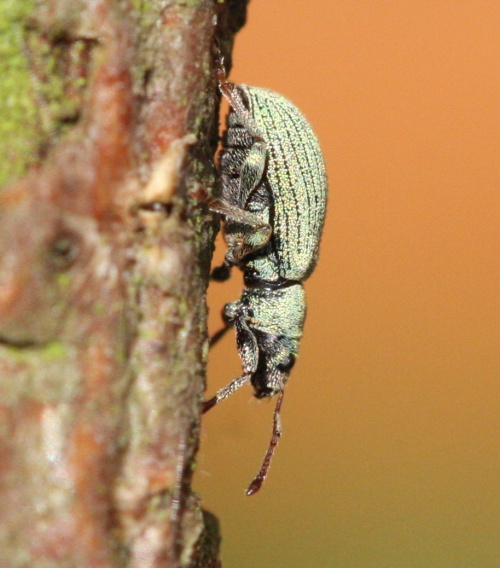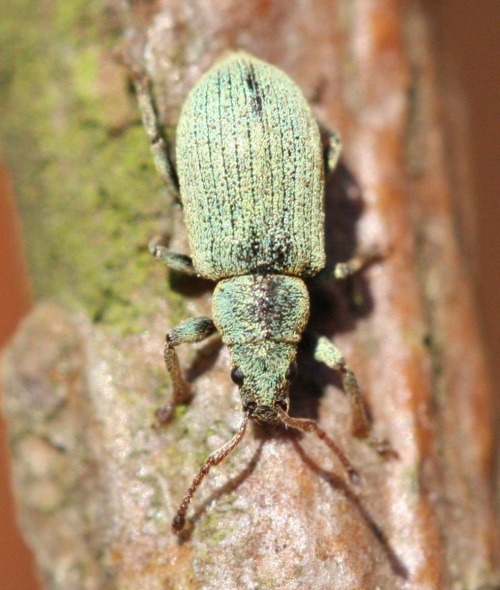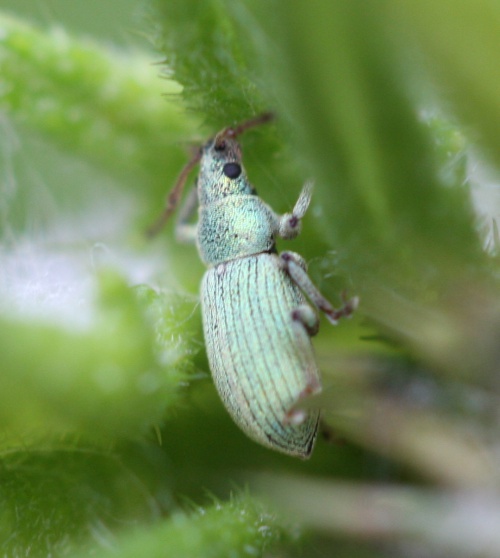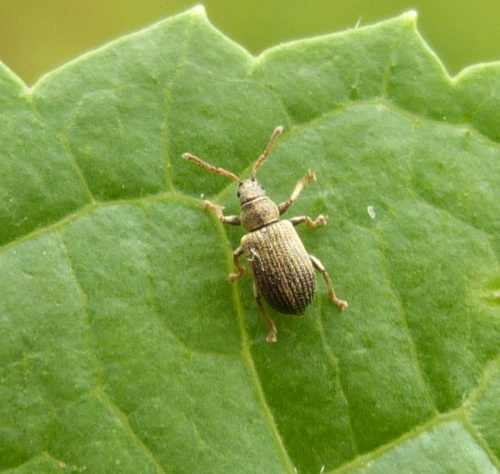Phyllobius roboretanus
A smallish green weevil about 5 mm in length, sometimes called the Small Green Nettle Weevil. Most Phyllobius weevils have a prominent tooth on the underside of the femora, but this is not the case with Phyllobius roboretanus. It also has a very steep, almost vertical, rear end to the elytra. It has round scales and dark femora.
This species is quite similar to P. virideaeris, which is another Phyllobius without the femoral tooth (the third is P. viridicollis but this lacks scales and appears black), but they differ on the underside. P. roboretanus only has a thin covering of fine scales, with much of the underlying surface visible. In P. virideaeris the underside is densely coated with round scales, the same as the upperside. P. roboretanus also appears rather earlier in the year. However the easiest way to separate them is by the steepness of the elytra at the posterior end - this is very steep in P. roboretanus but shallow in P. virideaeris.
See ID Aids below.
Phyllobius is a genus of broad-nosed weevils that are commonly found on low herbage and in trees during spring and summer. Most are covered in metallic green scales that give them a very attractive appearance. There are 9 species and most look similar but they can be separated by carefully comparing the range of features shown in the table below, either under a binocular microscope or with a x20 hand-lens.
Phyllobius weevils can be distinguished from the similar genus Polydrusus by looking where the antennae emerge from the rostrum. In Phyllobius the antennae emerge from the top whilst in Polydrusus they are positioned at the side. When looking directly down on the beetle it is usually clear to see.
Unless identified by a recognised expert, photographic evidence is required and the specimen should be examined with a microscope. In the comments box, state the key or ID method used. Note the beetle's size and describe the identifying characters. It is advisable to retain the specimen in case further checks are needed.
Often in foliage of trees and bushes.
Appears from late April onwards.
Widespread and quite common in much of England and Wales.
Fairly common in Leicestershire and Rutland.
Leicestershire & Rutland Map
Enter a town or village to see local records
MAP KEY:
Yellow squares = NBN records (all known data)
Coloured circles = NatureSpot records: 2025+ | 2020-2024 | pre-2020
UK Map
Species profile
- Common names
- Small Green Nettle Weevil
- Species group:
- Beetles
- Kingdom:
- Animalia
- Order:
- Coleoptera
- Family:
- Curculionidae
- Records on NatureSpot:
- 22
- First record:
- 23/06/1979 (Don Goddard)
- Last record:
- 07/06/2024 (Nicholls, David)
Total records by month
% of records within its species group
10km squares with records
The latest images and records displayed below include those awaiting verification checks so we cannot guarantee that every identification is correct. Once accepted, the record displays a green tick.
In the Latest Records section, click on the header to sort A-Z, and again to sort Z-A. Use the header boxes to filter the list.













